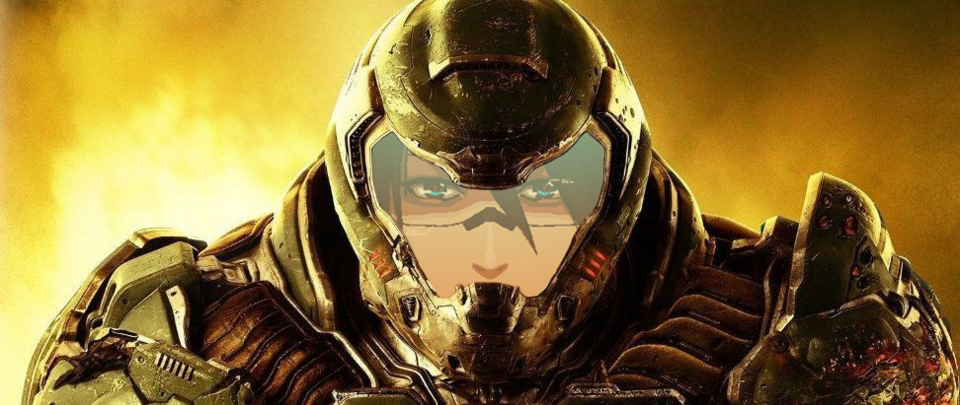That’s Good, That’s Bad: SIGNALIS
By PurpleShyGuy 7 Comments
Hello, and welcome to the eighth instalment of a series that I’m calling That’s Good, That’s Bad, based on a joke in the Simpsons in which Homer buys a cursed Krusty doll from what I now see as a pretty racist stereotype of an asian person. The gag is still good though, good enough for me to form a sort of review process in which I alternate between saying something good about a game, then something bad about it. This time my game of choice is Rose-engine Games’ shit-is-locked simulator Signalis.
Low-poly beauty…that’s good.
With seemingly every indie game under the sun ransacking people’s nostalgia for the 8 and 16-bit era, we are now seeing the quaint and blocky PS1 style showing up and saying “hey, you remember when games looked like this?” Naturally it benefits from visual touches that weren’t possible back then, you need only to look at the part where your character goes down an elevator and see how the shadows move to know that shit isn’t possible on a PlayStation One. Animations are slick, especially when you reload your gun with bullet casings emitting smoke particles as they fall to the ground. And the combat music sounds like a robot plummeting down some stairs that are made entirely of saucepans, but in a hauntingly good way.

I get it, you like the number six…that’s bad.
At this games creation a terrible curse befell the developer which prevented them from counting beyond the number six. Six planets, six keys, six photos, six stone plates, six cards, six spears, but you know what I had to do more than six fucking times: go back to the save room to free up inventory space. That’s because – you guessed it – you’re only able to carry a maximum of six items. Yes, limited inventory exists to force the player to make difficult choices, and yes, they do actually explain why you can only carry six items, but in the end all it did was grab the pace of the game and put it in a headlock for a minute.
Come for the horror, stay for the abject misery…that’s good.
It’s strange to give a thumbs up for something that made me feel so utterly hopeless, but here we are. You follow the story of Elster, a robot looking for a lady in a mining facility that has come down with a case of the killer zombie machines. Even if you haven’t played this game, you already know Elster isn’t coming out of this with her love in her arms skipping away into the sunset, but still, Signalis has a way to make you feel even more depressed than you initially braced yourself for. This tragedy extends to everyone trapped in Signalis’ nightmare, with some accepting their dire fate while others hold out for help that will never come.
The door prompt can be a fickle soul…that’s bad.
Of all the horrid mangled shells of humanity that roam Signalis’ broken and desolate hallways, none stuck fear into my heart like the unassuming door does. I don’t know if this is some sort of bug or I was trying to enter at the wrong angle, but the prompt for the door just wouldn’t appear sometimes. It’s a small annoyance when you are just doing some exploring, but it grows into a very big one when you’re running for your life and the door just decides to not open because it thinks you should take some damage, you know, to keep things fair for the monsters I guess?
Survival horror planning pleasure…that’s good.
The hallmark of a good survival horror for me is planning your routes, that mental gymnastics of trying to find the most expedient path that also manages to hit every room you need in order to complete your task. Scanning the map and trying to remember which room had what items and what enemies before heading out for another run is something I find quite absorbing. Signalis even has the body-burning mechanic which it has pilfered from its many influences, adding another layer of intriguing decision making to the process.
The roll of the dice that is wandering enemies…that’s bad.
The fact that monsters tend to patrol around a room somewhat isn’t a big deal if you’re gunning down everything. However, for those who are trying to play Sam Fisher style, you can just straight up run into enemies which leads to getting a big old whack on your noggin, or at the very least alerting everyone to your presence. This is more down to the fact that enemies can wander too close to doors, which usually ends up with you having to make a hasty retreat and wait until for a few seconds until they’ve waddled away from the door.
Puzzle design that hits the sweetspot…that’s good.
It’s a tight line to walk to have puzzles that are solvable by the average cretin (by which I mean me) but also give you the satisfaction of feeling smart. Most of Signalis’ puzzles are memorising a thing you saw a few rooms ago and using that information to open the safe or lay the cards in the right order or put the rings on the right finger and so on. Thankfully, all documents are stored in a database once you’ve read them and can be accessed during a puzzle if need be. You even get an item that lets you take pictures (if want to know how many it takes, the answer is in the third paragraph), cutting down on backtracking time.
Yes Signalis, I want the item that I’m standing right next to…that’s bad.
When it comes to picking up items, video games usually either do it automatically once you’ve pressed the button, or they will freeze time with a “yes or no” prompt appearing. Apparently Signalis wanted to do it some accursed third way in which time doesn’t stop but you still get the “yes or no” prompt anyway. It’s a system that’s the worst of both worlds since you can’t pick something up in a hurry and you don’t get a little breather to decide you next move either. And don’t say it adds realism since you’re making the choice in realtime, because in the real world I make the choice to pick up something when I first see it, not by going right up to it and gawking at it for second.
Endings that will ignite discourse for days…that’s good.
After finishing Signalis and staring out of a window for a while in a haze of sadness and confusion, I looked online to get some answers and eventually stumbled on a two-hour long video detailing everything that was fact and theorising everything that wasn’t. I always think that I’ll never get drawn down the rabbit hole whenever games like these come out, since I’ve done it for so many in the past, with Dark Souls, Nier: Automata and the Metal Gear series to name a few. But here I am once again, going down that hole, and it has been fascinating to hear everyone’s differing opinions on what it all means. For me, Signalis is about the importance of individualism, and you could even say that the game’s premise is individualism striking out against a power that sees the people under it as anything but individuals. Signalis leaves so much to interpretation because the creators want your own take on it, not to force feed you an opinion.

Nowhere can burn in hell…that’s bad.
Truth be told when I got to the middle part of this game in which you find yourself in a location called Nowhere, I almost quit the game. As all my previous problems culminated into a particularly annoying sundae, the cherry on top was the fact that there is no map for Nowhere. And wouldn’t you know it, the camera will switch positions as you go through doors to make it even more confusing to navigate. I know being lost is kind of Nowhere’s deal, but that doesn’t make it any less tedious to go through, and it also retroactively makes me hate Silent Hill 1 for inspiring it.
So is Signalis good or bad?
Raw and uncompromised, Signalis plays by its own rules which can come across as almost antagonistic to the player, yet its ability to take from so many influences and fashion them into its very own thought-provoking piece is extremely condemnable. Most will either bounce off it hard or fall deeply in love with it, but a divisive game is usually an interesting one.
